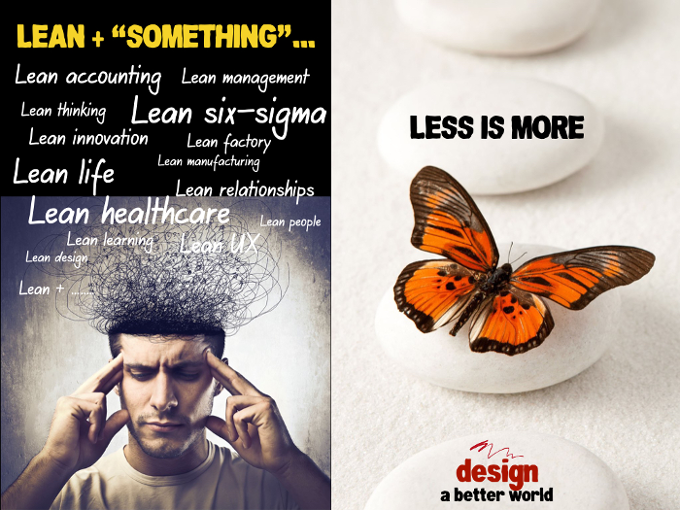Lean + “something” …
 Lean six sigma, lean sales, lean leadership, lean start-up, lean management, lean production, lean manufacturing, lean innovation, lean manager, lean style, lean academy, lean enterprise, lean+agile, lean people, lean relationships, lean thinking, lean design, lean evolution, lean products, lean maintenance, lean coffee, lean healthcare, lean factory, lean IT, lean green, lean black belt, lean poker, lean solution, lean UX, lean learning, lean entrepreneur, lean office, lean brand, lean accounting, lean change…
Lean six sigma, lean sales, lean leadership, lean start-up, lean management, lean production, lean manufacturing, lean innovation, lean manager, lean style, lean academy, lean enterprise, lean+agile, lean people, lean relationships, lean thinking, lean design, lean evolution, lean products, lean maintenance, lean coffee, lean healthcare, lean factory, lean IT, lean green, lean black belt, lean poker, lean solution, lean UX, lean learning, lean entrepreneur, lean office, lean brand, lean accounting, lean change…
Yikes! I’m stopping there!
Google the word “lean” and you’ll get 224 million results. It doesn’t strike me as appropriate to cite them all.
The formula is very simple.
Take the word “lean” (adjective) and add (plus, +) a noun to get something like this: lean car, bus lean, lean ticket, lean tax (how we could do with that right here in Italy), lean home, lean road, lean shirt, lean neck, lean garden.
We can guess at some more “business sensitive” ones: lean business, lean marketing, lean customer service, lean human resources, lean people, lean boss, lean strategy, lean excellence, lean canvas, lean talent, lean development, lean R&D, etc., etc.
In Italian we could enter a noun (“something”) followed by the word “lean”: pensions lean, accountants lean, electricians lean, pump attendants lean, bureaucracy lean (a nice oxymoron), etc., etc.
Or these good ones: lean cartoon, lean creative ideas, lean lab, lean writing, lean bar, lean sushi bar, lean shoes, lean umbrella, lean beach (very musical), lean climbing, lean tennis, lean football, lean athlete, lean singer, lean music, lean theater.
The combinations are truly infinite.
Where did this “lean + something” fashion come from?
In my view, there are basically two reasons for it.
The first is simply a commercial one: the word “lean” is in vogue.
Companies have for some years now been highly sensitive to any suggestions of “lean”. So, if you want to do business, just use this magic word to open up a whole range of opportunities with any such companies and organizations wanting to “do lean”.
I have written a few posts on the topic. And, should you have the inclination and the patience to read them, I suggest two:
Temples and old templates (12 April 2015)
Lean, Toyota and the quest for the Holy Grail… (July 7, 2014)
The second reason is subtler.
The implied meaning of the word “lean” is that of having reduced waste. Therefore, whatever comes after that adjective becomes, magically, lean! – “efficient”, with a very low level of waste. If a company implements the principles of “lean + something”, it will magically draw on the magical secrets developed by the gurus of lean and transform its business from inefficient to efficient and become like Toyota.
Lean means doing more with less. An attractive concept for anyone looking for a recipe for transforming their organization. Valid, simple, effective and reproducible tools; little temples with a variable number of columns (I discovered that in Word Class Manufacturing you can buy the pillars one by one, Sir!). Surefire, easily implemented solutions. What’s not to love?
But what would Sakichi Toyoda, Kiichiro Toyoda, Taiichi Ohno and Edwards Deming make of this incredible proliferation of “lean + something”?
Well, for a start, “lean + something” is not lean …
That “+ something” is waste or, to say that Japanese style, we could say it is MUDA (it does not create value). At the root of everything applied by great thinkers like S.Toyoda, K.Toyoda, T.Ohno and E.Deming to organizations (and not sanctioned in temples) is the idea that everything we do can be improved, constantly and incessantly. And not just during “Kaizen weeks”, but in every place, in every area (the whole company). Everyone must take part in this improvement every day. So, if we take a look far back, to before the Americanization of the concept, we find that lean was preceded by Kaizen = change to improve (the Japanese word essentially means to trace a path towards perfection and I hope, given current trends, that this will not in turn become “kaizen + something”).
Changing to improve is applicable to everything: to entire organizations as well as to pursuits unrelated to manufacturing, to sports, and to people on a personal level.
Speaking of sport (and I know some readers will already be thinking about lean sport…) I quote the following passage from Giuseppe Vercelli’s “Winning with the Mind”, published by Ponte alle Grazie (available in Italian):
This (kaizen) philosophy considers the past as fundamental to building for the future, via a process which leverages the improvement areas previously identified. Moreover, this philosophy is based on the belief that every human effort, albeit mistaken, enables us to grow or change strategy.
(…) The application of kaizen philosophy often means changing one’s strategy or one’s way of thinking in order to constantly improve. The Eastern view of kaizen interprets an athlete’s testing of his or her limits ecologically. It is safe to say that we are all, whilst not necessarily being athletes, curious to know how far we can push ourselves towards a particular undertaking or personal or professional goal. Attempting to overcome our limitations and continuous improvement are normal, physiological human needs.
I recently saw the image of a small temple with an astounding quantity of bricks, each representing a tool or technique, appear on the Internet. I try to imagine what might have happened had someone presented Taiichi Ohno with such a diagram…
And what to say of those who, before it became fashionable several years ago, began applying improvement principles in business prior to the advent of these plans and diagrams, so well sanctioned and drawn up?
I find these devastating diagrams misleading and dangerous.
We have completely lost the spirit of learning by doing and have forgotten that the search for improvement is first personal and then collective (team) and that this requires a sensei (先生, literally “person born before another”. This Japanese term typically means “master” or “teacher”. As well as referring to state school teachers, the term sensei is also used in Buddhist schools and in traditional arts and technical schools, where the “master” is not seen merely as a teacher of knowledge, but also as an individual endowed with authority and experience; or rather, as a “teacher of life.” Wikipedia).
The master-disciple relationship, so common in Japanese and martial arts, becomes the path of personal growth for the disciple who is led towards the discovery – in this case – of the improvement and processes necessary to achieving it.
In some companies, those which improve with conviction and seriousness, the person assigned to “kaizen” work usually must, in order to be a real “sensei”, be an individual with many years of experience, someone with charisma and authority derived from that experience, with the proven ability, demonstrated over the years, to develop others.
In contrast, we frequently see the insertion of recent graduates (who have a low cost advantage), preferably engineers, sent into the fray amidst colleagues with years of experience and whose bad tempers and frustrations have accumulated over time. These young graduates are thus condemned to failure or their intervention strategies subjected to the usual performance upgrades. These young people, and I have met many of them, are exceptional, determined and capable men and women, but they have limited on the job understanding and lack experience handling “savvier” colleagues. They thus succumb, in despair and with a sense of powerlessness, to the unwritten laws of the organization. They do not receive adequate support and stand in a vacuum in which leadership is either non-existent, removed from operations or distracted.
Responsibility for failure, of course, is not theirs. Responsibility lies with the people in the organization who should have a different and more mature outlook, but instead, either boorishly follow company “guidelines” set down by someone somewhere in the world, or take decisions on matters they know nothing about.
This shows how “lean” thus interpreted, which Bob Emiliani aptly calls “Fake Lean”, is: the application of the instruments with no attention to people.
He (Anders Ericsson – psychologist of Swedish origin) has provided scientific evidence to support to the fact that, in our species, peaks of excellence are not reached because of genetic determinism, but through a voluntary process. Absolute performance in any field, from arts to chess, from sports to scientific research, is primarily the result of practice, rather than innate ability.
(…) The conclusion of Ander Ericsson’s research work is now known by the name of “the ten thousand hours theory.”
(…) However, according to Ericsson, people who achieve mastery, which is to say a high level of mastery, tend to postpone reaching a level of automation in execution by setting themselves increasingly challenging objective exercises, requiring awareness. These exercises provide greater stimulation for the nervous system and more time for it to expand in complexity. Eventually, execution becomes automatic, but the mastery of gesture will be of incomparably higher quality. Intentional exercise usually requires a master, that is to say a person who has already experienced the process themselves, to provide the right goals and feedback.
(Pietro Trabucchi – Techniques for Inner Strength – available in Italian)
Using junior employees in improvement activities is yet another demonstration of how some companies think and operate with logic (the “apparent” containment of costs) which runs contrary both to common sense and to the scientific evidence.
Who for that matter would take lessons from a swimming instructor who could barely float or from a golf instructor with three months’ experience?
Furthermore, imagine a company with a strategic project to undertake. Would it be better for them to assign their best resources to this task? The most experienced and capable people? Or would it be better if they assigned their lead experienced people, individuals who have recently joined the organization perhaps?
By choosing to assign “economic” resources to the project, management are stating that continuous improvement is of very low importance (in contrast to any bombastic declarations). So the project is doomed to failure before it has even begun.
If I really must conform to fashion “jingles” then I would say I prefer the term “REAL LEAN” used by Bob Emiliani (with whom I share a deep understanding on various issues) as a synthesis of two spheres that must coincide for ethical and sustainable improvement: continuous improvement and respect for people.
The tendency to assign labels and identify categories is typical of human beings, but we do not like or want to be classified as lean. Lean seems simplistic, misleading and not representative of what we do and, may I add, quite frankly… dated, old.
Obsolescence aside, having seen its disasters and failures, we do not identify with “lean + something”.
I like to quote Emily Pilloton (founder and executive director of Project H Design, a non-profit industrial design organization):
I believe that design is problem solving with grace and foresight.
That I believe there is always a better way.
That I believe that design a human instinct, that people are inherently optimistic, That every man is a designer, and that every problem can either be defined as a design problem or solved with a design solution.
What with its synthetic, commercial, advertising usage, we are happy to leave “lean + something” to others.
We like the designer label, helping others (companies and individuals) and working in order to build a better future.
We feel we are designers.
Less is more!
Have a good week
Massimo

